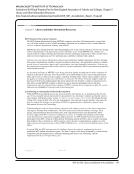SPEC Kit 330: Library Contribution to Accreditation · 47
SACS asks for evidence related to collections, services, instruction, learning resources, facilities, and staff. The standards
are not prescriptive, so it is up to the institution to produce evidence that shows it is meeting its mission.
Strategic plan. List of library faculty committees committee reports/minutes for previous year. Current and potential
collaborations between library and other campus units. Library faculty professional development data: name of
development activity, category (e.g., leadership development, recognition and awards), number of faculty, source of
funds and amount distributed per year. Library faculty constitution and bylaws. Library faculty curriculum committee
responsibilities, teaching assessment methods, teaching workshops, professional development funds for teaching
and innovative practices. Library faculty professional association membership and offices held, journal editorship and
editorial board membership.
We provided white papers, peer comparisons, policies, staff survey results, space surveys, graduate student survey
results, and results of a photo study within the library.
Website usage. Attendance in library instruction sessions. Tutorial usage and quiz scores.
18. If your library collects qualitative data to report for accreditation purposes, what method(s) do you
use? Check all that apply. [Source: Berry, Leonard L., On Great Service: A Framework for Action. New
York: Free Press, 1995.] N=16
Total Market Surveys (to measure customers’ overall assessment of library services, e.g., LibQUAL+®) 13 81%
Focus Group Interviews 11 69%
Customer Advisory Panels 8 50%
First year and/or graduating year student customer surveys 5 31%
Service Reviews (periodic visits with customers or class of customers to discuss service relationship) 2 13%
Transactional Surveys (done with customers in the aftermath of a service transaction) 1 6%
Employee Field Reporting (research of internal customers) 1 6%
Other method 8 50%
Please describe the other method.
Anecdotal evidence from customers.
Feedback provided through Questions &Comments page of library website.
Graduate Student Survey (designed and implemented by Reference &Instruction staff). Staff Survey (we use the Are We
Making Progress surveys designed by the Baldrige Program). Photo Survey (designed and implemented by Reference &
Instruction staff -based on model from University of Dayton).
Library contributions to academic program reviews.
Periodic user surveys developed in-house.
SACS asks for evidence related to collections, services, instruction, learning resources, facilities, and staff. The standards
are not prescriptive, so it is up to the institution to produce evidence that shows it is meeting its mission.
Strategic plan. List of library faculty committees committee reports/minutes for previous year. Current and potential
collaborations between library and other campus units. Library faculty professional development data: name of
development activity, category (e.g., leadership development, recognition and awards), number of faculty, source of
funds and amount distributed per year. Library faculty constitution and bylaws. Library faculty curriculum committee
responsibilities, teaching assessment methods, teaching workshops, professional development funds for teaching
and innovative practices. Library faculty professional association membership and offices held, journal editorship and
editorial board membership.
We provided white papers, peer comparisons, policies, staff survey results, space surveys, graduate student survey
results, and results of a photo study within the library.
Website usage. Attendance in library instruction sessions. Tutorial usage and quiz scores.
18. If your library collects qualitative data to report for accreditation purposes, what method(s) do you
use? Check all that apply. [Source: Berry, Leonard L., On Great Service: A Framework for Action. New
York: Free Press, 1995.] N=16
Total Market Surveys (to measure customers’ overall assessment of library services, e.g., LibQUAL+®) 13 81%
Focus Group Interviews 11 69%
Customer Advisory Panels 8 50%
First year and/or graduating year student customer surveys 5 31%
Service Reviews (periodic visits with customers or class of customers to discuss service relationship) 2 13%
Transactional Surveys (done with customers in the aftermath of a service transaction) 1 6%
Employee Field Reporting (research of internal customers) 1 6%
Other method 8 50%
Please describe the other method.
Anecdotal evidence from customers.
Feedback provided through Questions &Comments page of library website.
Graduate Student Survey (designed and implemented by Reference &Instruction staff). Staff Survey (we use the Are We
Making Progress surveys designed by the Baldrige Program). Photo Survey (designed and implemented by Reference &
Instruction staff -based on model from University of Dayton).
Library contributions to academic program reviews.
Periodic user surveys developed in-house.
























































































































































































